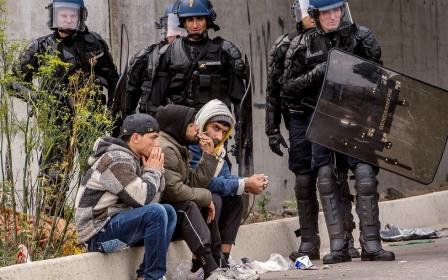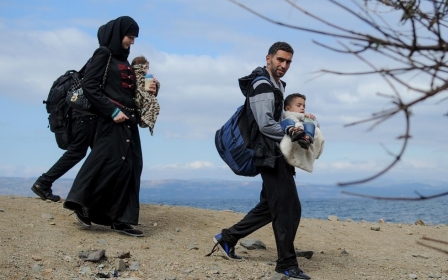Fact check: Is Syria really Europe's biggest refugee and migrant crisis?

Media and politicians alike have said Europe is facing its worst migrant and refugee crisis since World War II, but some historians have challenged that notion.
Quantifying the current crisis remains complicated as the numbers keep growing and few know when it might end. In the first eight months of the year, more than 500,000 people entered the EU with hundreds of thousands more continuing to make the journey every month. Last year, more than 400,000 people came to the EU, with numbers of new arrivals growing annually over the last several years.
The UN refugee agency (UNHCR) has said it expects no let-up in the waves of people crossing the Mediterranean to seek safety in Europe as Syria's civil war, the main factor driving refugees towards Europe, rages on with little hope for peace in the short-term.
Here are some questions that aim to put Europe's current crisis into context.
Is this EU's worst migrant and refugee crisis?
Historians have challenged the "worst crisis" label specifically when dated back to WW II because academics typically draw a line between the war itself and the huge displacement on the continent through the latter half of the 1940s.
Debate on statistics persists, but there is research indicating that more than 11 million Germans were expelled from other European countries after the war, said Pamela Ballinger, a refugee expert at the University of Michigan.
Separately, about two million Russian nationals living elsewhere were ordered to return to the Soviet Union.
Hundreds of thousands of Jews, many of whom stayed in the Soviet Union through the war, were also forced to move.
These figures dwarf those related to the current crisis: the number of migrants, mainly from the Middle East and Africa, who have landed on Europe's shores over the last three years is still estimated at below one million.
When talking European history since 1991 - when the treaty forming the European Union was signed at Maastricht - the "worst crisis" label seems to apply, with one possible exception: the war in Bosnia.
Compared to Bosnian war?
UNHCR previously said that the 1992-1995 war in Bosnia sparked "the greatest refugee crisis in Europe since the World War II".
At least 2.5 million people were forced from their homes in Bosnia. This includes 1.3 million who were internally displaced, as well as 500,000 refugees who fled to neighbouring countries and another 700,000 refugees who moved to Western Europe, according to UNHCR.
Key differences between the Bosnian crisis and the current one include the fact that in Bosnia, most people were displaced relatively near their home and had not come from other continents.
Also, the UN and other humanitarian groups caring for Bosnia's displaced were operating in a conflict zone, unlike today, where getting aid to migrant arrivals in Greece, for example, does not require negotiation with armed combatants.
Despite initial inaction, Western European powers and the US were able to forge a political solution to the Bosnian war, which ultimately helped contain the refugee crisis.
Prospects for such a political solution in Syria remain uncertain.
How big is it historically speaking?
The creation of an independent Pakistan in 1947 led an estimated 14 million people to move, including Muslims in India who fled to Pakistan and Hindus in Pakistan who went to India, according to UNHCR.
Later, the civil war in Pakistan sparked the flight of some 10 million people in 1971, although most ended up returning to what became an independent Bangladesh.
The conflict in former British mandate Palestine, which continued after the creation of Israel in 1948, displaced more than 720,000 Palestinians, according to the UN.
This year, the UN agency responsible for those displaced from Palestinian lands had registered more than five million refugees, including the descendants of those who lived in British Palestine between 1946 and 1948.
Aside from the more than 800,000 people who were slaughtered, the 1994 genocide in Rwanda also displaced about half of the country's seven million people.
At least 1.5 million fled their homes within the country, and another two million ran into neighbouring states as rebel forces advanced towards the capital Kigali before toppling the extremist government which presided over the genocide.
Refugees from the Soviet occupation of Afghanistan in the 1980s led to more than 6 million people having to leave the country, mostly fleeing to neighbouring countries, 3.3 million to Pakistan and 3 million to Iran by 1990. Although some returned during the 1990s, continued conflict meant that by 2000, some 2 million refugees remained in Pakistan and 1.5 million in Iran.
Most of those fleeing Syria's ongoing civil war have not made their way to Europe - more than four million Syrians have taken refuge in neighbouring countries, while 7.6 million are displaced inside the war-ravaged country.
For these reasons, claims that the Syrian refugee crisis, combined with refugee movements from other conflict zones including Iraq, Afghanistan, Sudan and Eritrea, is the largest in Europe since WWII, are not backed up by the facts. In world terms, a number of other refugee crises have been of equal or greater scale in numbers and duration since 1945.
New MEE newsletter: Jerusalem Dispatch
Sign up to get the latest insights and analysis on Israel-Palestine, alongside Turkey Unpacked and other MEE newsletters
Middle East Eye delivers independent and unrivalled coverage and analysis of the Middle East, North Africa and beyond. To learn more about republishing this content and the associated fees, please fill out this form. More about MEE can be found here.




